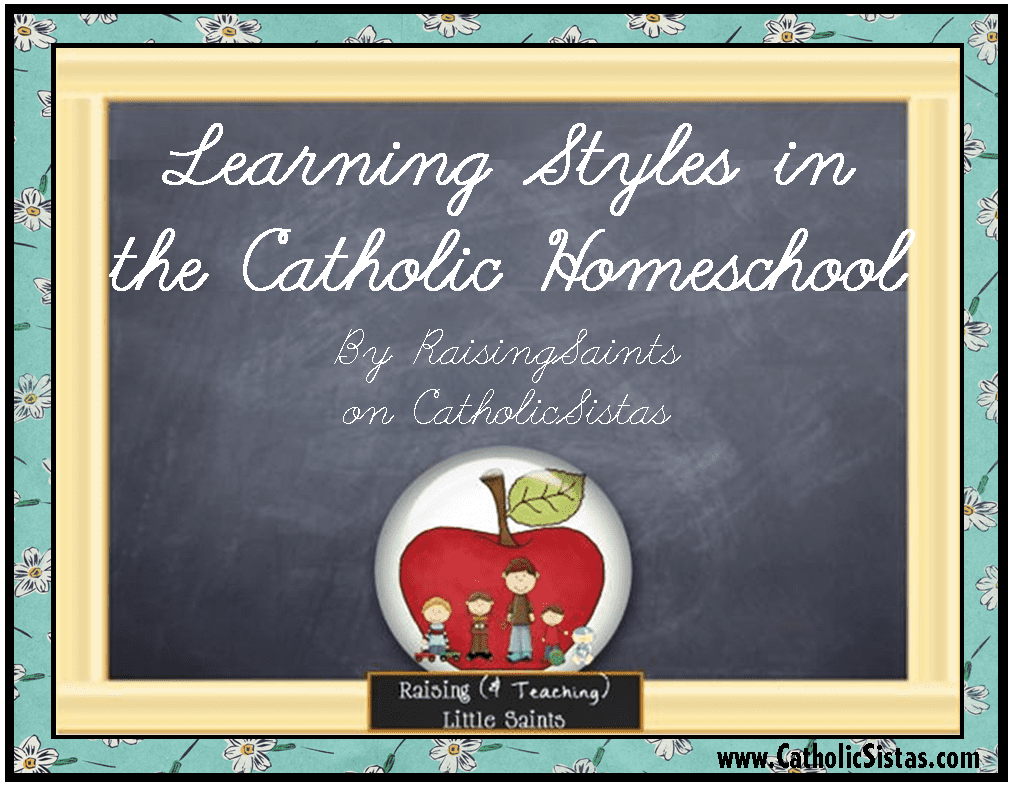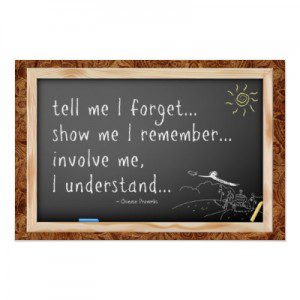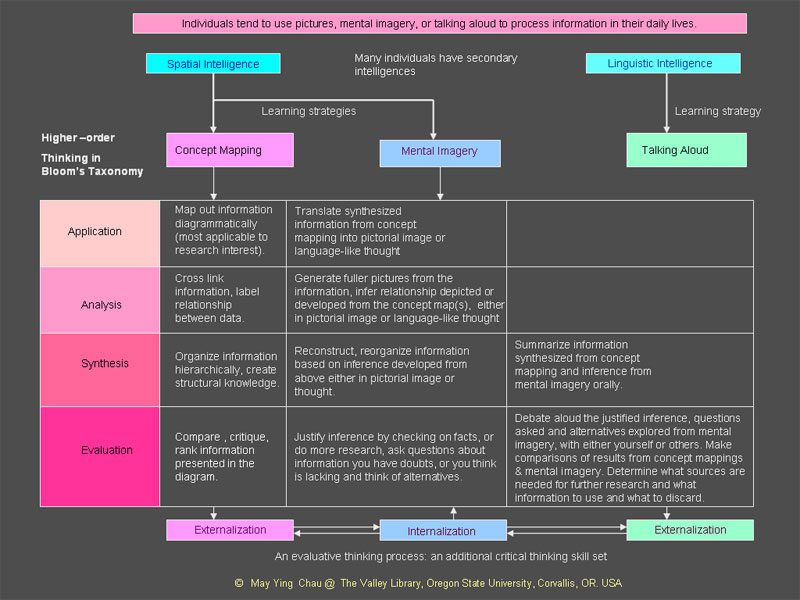 My husband is incredibly smart. He goes to visit someone once and two years later he knows exactly how to get there without directions. He can also capture what someone tells him the first time he hears it. Is your husband like this? Are you? I am not. I have to look at the map, write down turn-by-turn directions and actually drive there myself to remember. What is the difference between him and I? He is an auditory learner and I am a visual learner. Some people learn best by just listening to someone talk about information others prefer to read about the concept to learn it, others, like myself, need a little more, we need to read, listen and also watch. These are what are known in the education field as learning styles.
My husband is incredibly smart. He goes to visit someone once and two years later he knows exactly how to get there without directions. He can also capture what someone tells him the first time he hears it. Is your husband like this? Are you? I am not. I have to look at the map, write down turn-by-turn directions and actually drive there myself to remember. What is the difference between him and I? He is an auditory learner and I am a visual learner. Some people learn best by just listening to someone talk about information others prefer to read about the concept to learn it, others, like myself, need a little more, we need to read, listen and also watch. These are what are known in the education field as learning styles.
Learning styles are, generally, the overall patterns that provide direction to learning and teaching. Learning styles are a set of factors, behaviors, and attitudes that facilitate learning for an individual in a given situation. These different styles influence how well students learn, how efficient teachers teach, and, most importantly, how the two can interact with one another. As I described the difference between my husband, and auditory learner versus me, a visual learner, each person is born with certain tendencies towards a particular style in which they learn best. These are influenced also by biological or inherited characteristics and influenced by culture, maturity level, development, and personal experiences. Why is this important to the homeschool teacher? Simple. What the student brings to the learning experience is as much part of the context as are the important features within the learning experience itself. Each student brings a consistent and specific preferred method of perceiving, retaining, and organizing information. Have you heard when someone says, “I’m a right-brain learner.” They are speaking of the different hemispheres of the brain which contain different perception avenues for learning. In a nutshell, “right brained” people tend to be verbal and “left brained” people are more mathematical.
As the student grows and matures, his brain is continually developing. The strengths and weaknesses he demonstrated at an early age may be different from when he is a teenager, this is because the child is constantly learning and developing new ways of learning. Over time, the brain matures along with your child. A homeschool teacher with multiple children in her home will find multiple learning styles. Effective teaching in small groups happens when teachers combine several approaches also known as multi-sensory instruction. In this method of instruction the child will use more than one sense at a time while learning something. Our brains are organized in a way that accepts this multi-sensory approach best. The more senses we use while learning the better we will retain information this is because when we learn, information takes one path into our brain when we use our ears (auditory), another when we use our eyes (visual), and then another when we use our hands (tactile). When we use more than one sense, we are actually saturating our brain with new information in multi-sensory ways and as an outcome, we learn better.

Tell me, I forget…show me, I remember…involve me, I understand. ~ Chinese proverb
So as the old Chinese proverb was not too far off as a recent study which was used in a chemical engineering class which shows that:
“A point no educational psychologist would dispute is that students learn more when information is presented in a variety of modes than when only a single mode is used. The point is supported by a research study carried out several decades ago which concluded that students retain 10 percent of what they read, 26 percent of what they hear, 30 percent of what they see, 50 percent of what they see and hear, 70 percent of what they say, and 90 percent of what they say as they do something.” (Stice, 1987)*
So basically, what you need to do to make sure your children are learning and retaining more information is to first diagnose which learning style your child is “gifted” in. This way, you will know which method they learn best in BUT you will not only teach this child in such method because you want to build upon the other learning styles to expose your student to multiple sensory learning. When the subject at hand is most difficult, you will then target the method they learn best in to teach them but do not limit them to just this method of learning. Hands on learning is always the best method to learning yet understanding a student’s learning styles is an important component of effective instruction. The four main learning styles are visual (sight), auditory (sound), tactile (touch) and kinesthetic (movement). The visual or spatial learning style is generally preferred by students who like to use pictures, maps, colors and images to organize and communicate information to others. Auditory learners prefer to listen, take notes, discuss, memorize and debate. Students who use the tactile learning style learn by touching and moving objects. Students who use the kinesthetic learning style like to use their whole body to learn.
Another person that developed this was Mr. Howard Gardner. In 1983, he initially developed his ideas and theory on multiple intelligences as a contribution to psychology, however Gardner’s theory was soon embraced by education, teaching and training communities, for whom the appeal was immediate and irresistible – a sure sign that Gardner had created a classic reference work and learning model. Mr. Gardner presented more “intelligences” as he believed people were gifted with more than just the four learning styles. I like his more descriptive approach to learning styles because it helps us, as teachers, understand our students better. Each child has certain strengths to them some are more apparent than others. Here is a quick chart of the Seven Multiple Intelligences:
| Intelligence Type | Capability and Perception |
| Linguistic | words and language |
| Logical-Mathematical | logic and numbers |
| Musical | music, sound, rhythm |
| Bodily-Kinesthetic | body movement control |
| Spatial-Visual | images and space |
| Interpersonal | other people’s feelings |
| Intrapersonal | self-awareness |
I have learned that as a teacher, it’s good to access what kind of learner I am first and then I assess what kind of learner my children/students are. Why? Sometimes we lean towards the style we like best but which may not be the best method for our students. If you would like to assess what kind of learner you are or better which intelligence you are more prone to, you can take this test based on Mr. Gardner’s theory. For your children, you would use this version of the test.
So you may be asking, this is all really cool but what do I do with it? Well, there is actually a reason I brought this topic up. Learning about your student’s preferred learning style, as well as their behavioral and work style, you also learn their natural strengths. I had a college professor who would always say, “use their strengths to build on their weakness!” when I learning to diagnose and help children with Reading problems. The types of intelligences that each student possesses (by the way Mr. Gardner believes that most people are strong in three of the above but always leaning towards one preferred), indicates not only your student’s capabilities but also the manner or method in which they develop their strengths and use these to build upon their weaknesses.
For example (these examples were found in this article on Multiple Intelligences):
- A person who is strong musically and weak numerically will be more likely to develop numerical and logical skills through music, and not by being bombarded by numbers alone. [remember those multiplication raps we grew up with?]
- A person who is weak spatially and strong numerically, will be more likely to develop spatial ability if it is explained and developed by using numbers and logic, and not by asking them to pack a suitcase in front of an audience.
- A person who is weak bodily and physically and strong numerically might best be encouraged to increase their physical activity by encouraging them to learn about the mathematical and scientific relationships between exercise, diet and health, rather than forcing them to box or play rugby.
So what does learning about Multiple Intelligences/Learning Styles do for us as teachers? It helps so as not to limit or judge our students, espcially younger children, according to just the one intelligence or “what they are really good at.” Instead, I invite you to rediscover different methods of teaching to promote the vast range of capabilities of your student. This will help them discover, as learners, who they are, what they can be, and also help them learn what they are potentially capable of.
Next week I will make the connection between the learning style/MI of your student with learning domains, or higher order thinking known as Blooms Taxonomy.

* Stice, J. E., 1987. “Using Kolb’s Learning Cycle to Improve Student Learning.” Engineering Education 77: 29 1-296.
In this {Catholic} Homeschooling Series:
10 Steps to Start {Catholic} Homeschooling
Goal Setting in {Catholic} Homeschooling
{Catholic} Homeschooling Methods 101
The {Catholic} Homeschooling Socialization Myth
Other Parenting/Homeschooling posts:
Holy Week: Helping Our Children Walk with Jesus
